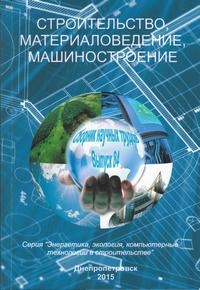Study cool internal surfaces of a room during a power failure heating system
Keywords:
Microclimate, microclimate parameters, comfort, teplooschuschenie, air temperature, surface temperature, relative humidity, air velocity, air composition.Abstract
Purpose. To analyze the influence of microclimate on life safety to meet the requirements of SDS 3.3.6.042-99 "Sanitary norms of microclimate of production rooms". The human body is in constant interaction with the environment. Change thermal conditions it leads to the automatic adaptation of the temperature and humidity condition of the skin due to the action of the thermoregulatory system of the body, but every body is different. Heat sensation in the more or less different from the average standard indicators indoor climate. Therefore, it was necessary to study the influence of microclimate on the safety of human life.
Methodology. Theoretical and experimental studies were carried out on the basis of fundamental knowledge in the field of thermal processes and techniques for solving problems of heat transfer, modeling of dynamic processes, methods and analysis of random processes, methods of mathematical statistics and forecasting.
Findings. Providing comfortable or acceptable parameters indoor climate depends on a number of factors (the gravity of works, period of the year) and, accordingly, their values are regulated by SDS 3.3.6.042-99 "Sanitary norms of microclimate of production rooms". Comprehensive assessment of the microclimate in the applicable parameters can be made equivalent to the largest-effective temperature Fig. 6 (a combination of the three parameters of the microclimate). Their combination could create comfortable or uncomfortable microclimatic conditions, which determine health, health and human performance in the workplace and at home.
Originality. The interrelation dynamics inside air temperature of the room to the temperature gradient with respect to the temperature of the inner surface of walling that allows you to manage the support of microclimate parameters to achieve the critical temperature of the internal air space, taking into account work performed in severity and critical values for operating temperatures utilities.
Practical value. The research allowed to develop an automated system for the control and supply of heat to control the temperature of indoor air cooling period and timely inclusion of reserve-intermittent heating when the minimum temperature.
References
Belikov A. Occupational safety at the enterprises construction industry / AS Belikov, AP Kozhushko, Vladimir Safonov. -Dnepropetrovsk: PE Fedorenko AA, 2010. - 528 p.
Vail YS Infrared rays in clinical diagnostics and biomedical research / YS Weil, YM Baranovsky. - L .: Medicine, 1969. - 247 p.
Demin O. B. Physical and technical bases of designing of buildings and structures: proc. p. – Tambov: The Compromise. state technical. University press, 2004. – P. 2. – 84 p.
Zaydshnur IA Information on the mechanism of action on the human body infrared radiation / IA Zaydshnur // Physical environmental factors. - M .: Medicine, 1960. - S. 282-290.
Zakharenko, I. M., Goncharenko N. I. The impact of environment on design of buildings and structures / Bulletin KTU. -Krivoy Rog: SIHE "Krivorzhstal national University", 2011. – Vup. 28. – S. 3 – 7. – Access mode: http://knu.edu.ua/Files/V_28_2011/18.pdf.
Kondrat'ev G. M. Regular thermal mode. – Moscow: Nauka, 1964. – 487 p.
Letavet AA Radiative heat transfer with the environment / AA Letavet // Occupational diseases and occupational injuries in the metals and mining industry. - M .: Stroyizdat, 1956. - P. 9-21.
Mishchenko S. V. Analysis and synthesis of the measurement systems / S. V. Mishchenko, Yu. L. Muromtsev, I. E. Tsvetkov, V. N. Chernyshov. – Tambov: The Compromise. state technical. University, 1995. – 238 p.
Evaluation of the thermal state of a person to justify hygienic requirements for microclimate of jobs and prevention measures of cooling and overheating: Guidelines. - M .: Federal Center gossanepidemnadzora Russian Ministry of Health, 2004. - 20 s.
Basics of receptionists pratsі: pіdruchnik / V. Ts Zhidetsky VS Dzhigirey, OV Melnikov. - View. 5th extra. - Lviv: Afіsha, 2002. -350 p.
Strezhekurov EE Improved safety for workers of hot shops metallurgical / EE Strezhekurov, Yu extinguished, GV Duganov. -Dep. in Ukrain. NIINTI 7.02.89, № 524-UK 89 - 13.
Tabunschikov Yu Building concept XXI century buildings in heating and air-conditioning / YA Tabunschikov // AVOK. - 2005. -№ 4. - pp 4-7.
Fokin K. F. Building heating equipment protecting parts of buildings / edited by J. A. Tabunshikova, V. G. Gagarin, 5th ed., revision. – Moscow: AVOK-PRESS, 2006. – 256 p.
Fenger R. IAQ in the XXI century: the impact on comfort, performance, and health / Fenger R. // AVOK. - 2003. - № 4. - pp 12-18.
Downloads
Published
Issue
Section
License
Редакція Видання категорично засуджує прояви плагіату в статтях та вживає всіх можливих заходів для його недопущення. Плагіат розглядається як форма порушення авторських прав і наукової етики.
При виявлені у статті більш ніж 25% запозиченого тексту без відповідних посилань та використання лапок, стаття кваліфікується як така, що містить плагіат. У цьому випадку стаття більше не розглядається редакцією, а автор отримує перше попередження.
Автори, в статтях яких повторно виявлено плагіат, не зможуть публікуватися в усіх журналах Видавництва ДВНЗ «Придніпровська державна академія будівництва та архітектури».
Автори, які публікуються у цьому журналі, погоджуються з наступними умовами:
- Автори залишають за собою право на авторство своєї роботи та передають журналу право першої публікації цієї роботи на умовах ліцензії Creative Commons Attribution License, котра дозволяє іншим особам вільно розповсюджувати опубліковану роботу з обов'язковим посиланням на авторів оригінальної роботи та першу публікацію роботи у цьому журналі.
- Автори мають право укладати самостійні додаткові угоди щодо неексклюзивного розповсюдження роботи у тому вигляді, в якому вона була опублікована цим журналом (наприклад, розміщувати роботу в електронному сховищі установи або публікувати у складі монографії), за умови збереження посилання на першу публікацію роботи у цьому журналі.
- Політика журналу дозволяє і заохочує розміщення авторами в мережі Інтернет (наприклад, у сховищах установ або на особистих веб-сайтах) рукопису роботи, як до подання цього рукопису до редакції, так і під час його редакційного опрацювання, оскільки це сприяє виникненню продуктивної наукової дискусії та позитивно позначається на оперативності та динаміці цитування опублікованої роботи (див. The Effect of Open Access).

